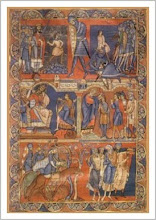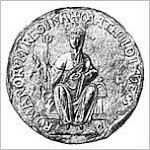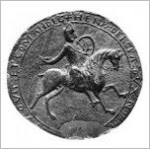• Sword, Lance, and Battleaxe
• The Destrier
• Anglo-Norman warfare
• Sword, Lance, and Battleaxe
General information and images of the type of Arms and Amour used in the Medieval period.

The sword and scabbard on the left has a brazil nut pommel, a large spatulate cross and the blade has a large central fuller.
In the middle is the so called 'Temple Pyx' of gilt bronze c.1140-50. It was probably originally part of a reliquary casket, and this fragment shows three mail clad knights with long gowns of cloth underneath their hauberks together with their familiar Norman kite shape shields with umbos.
The grip of the sword on the right is bound with red and yellow silk, the pommel is bronze and the cross iron. The belt fittings on the scabbard are of buckskin.

Left: a Viking sword c.1000 found in the River Thames, London. It's blade is inlaid in iron with the maker's name, INGELRI.
Middle: medieval spear and lance heads excavated in London.
Right: Viking age spearheads and broad axe heads found in the River Thames, near London Bridge. Battleaxes such as these were capable of severing a man's head from his shoulders.

Left: Scandinavian c.850-950. The hilt is overlaid with latten decoration incorporating the letters HLITER.
Middle: German 11th century.
Right: southern European 12th century.
All from the Wallace Collection

The Construction of Mail:
A theoretical sequence of medieval mail manufacture, since no original tools survive. Drawn soft iron wire wrapped around an iron mandrel is cut into links with a cold chisel. Alternatively a simple punch and former may have been used to form the rings. Another tool simultaneously flattens and shapes the end of each link. A third tool pierced each with a slot. Wedge shaped rivets were probably cut from a flat metal strip, and the mail assembled, four links through every one. The raised rivet heads faced out. The mail was case hardened or if mild steel, quench hardened.
Detail of a German riveted mail shirt showing the brass ring stamped 'Bernart Couwein'. The diameter of each link is 1cm, and the shirt weighs approximately 9kg.
A fifteenth century mailmaker. Over 30,000 links were needed to make one mail shirt.
Acknowledgement & Recommendation:
"Arms & Amour of the Medieval Knight" - David Edge & John Miles Paddock. For anyone who is interested in finding out more about arms and armour in the medieval period I particularly recommend the aforementioned book. I found it a great introduction to both medieval warfare and the development of the equipment used in each century. It is very informative, easy to read, contains lots excellent of images, and is very nicely presented.
• The Magnificent Destrier
Sometimes forgotten in discussions of the medieval knight, I've included in the arms and armour section information about the magnificent destriers and the equipment knights used with them. Destrier doesn't refer to a breed, but to a type of horse: the finest and strongest warhorse, which were usually stallions, bred and raised for the needs of war.
The Bayeux Tapestry clearly shows that the war horses used by the Norman knights were all stallions and also the type of saddle used. This was secured by a single breastband and girth and had an upright bow in front with an equally high cantle behind, both curling outwards. It had long stirrup leathers giving a deep straight-legged seat, so that the knight was virtually standing in the saddle, enabling him to use it as a fighting platform both to take his weight and hold him securely in place while delivering or receiving blows. The Tapestry also shows mounted knights wearing spurs.

10th or 11th century iron stirrup overlaid with bronze, incised and pointille decoration, and an 11th century style prick spur.
• Anglo-Norman warfare
Articles on Anglo-Norman Warfare and Gesta Stephani and Primary Sources on Anglo-Norman Warfare:
• Anglo-Norman Warfare courtesy of De Re Militari: The Society for Medieval Military History
Interested in Castle Warfare? The following links provide some fascinating insights into castle warfare from the Gesta Stephani, written in the time of King Stephen.
• Castle Warfare in the Gesta Stephani
• The Siege of Bristol and other matters from the Gesta Stephani
Please note the acknowledgements and notes at the bottom of each article. Gesta Stephani, edited and translated by K.R.Potter (Oxford: Clarendon Press, 1978)
If you are interested in the medieval tournament the following link Tournaments at the Dawn of the Age of Chivalry provides some great information on the development of the tournament in the eleventh and twelfth centuries, the era from William the Conqueror to Richard I.








No comments:
Post a Comment